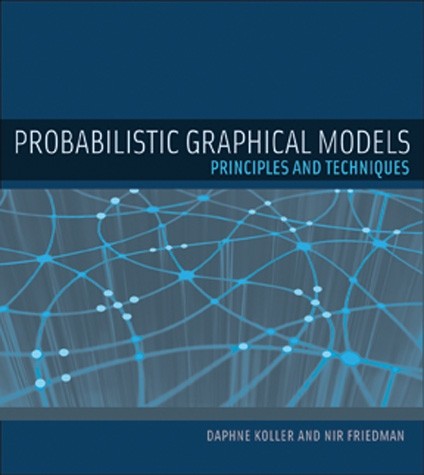Expected Maximization by example
Written on August 15th, 2020 by Sergei Semenov
The Simplest example of Expected Maximization Algorithm
What could be simpler then just a naive CPD bayesian network with 2 observed outputs (\(X_1\) and \(X_2\))? Let’s take it and see how EM works.
The \(X1\) and \(X2\) are observed and \(C\) is not observed. Our data set consists of the following samples: \(D=\{x_1[m], x_2[m] \}_{m=1}^M\). For our test example we can assume, that \(X1\) and \(X2\) are binary values.
Is it a Clustering?
Yes, we can state, that in this particular form we do clustering. Our task sounds: “Given a set of data points, we want to classify each data point into a specific group”.
How to select cardinality of C?
One option is to select it manually using some prior knowledge. I would prefer to have it binary for our example. Then our CPD tables would look like:
| \(P(C)\) | |
|---|---|
| 0 | \(\theta_{C=0}\) |
| 1 | \(\theta_{C=0}\) |
| \(P(X_1 \mid C = 0)\) | \(P(X_1 \mid C = 1)\) | |
|---|---|---|
| 0 | \(\theta_{X_1=0, C=0}\) | \(\theta_{X_1=0, C=1}\) |
| 1 | \(\theta_{X_1=1, C=0}\) | \(\theta_{X_1=1, C=1}\) |
| \(P(X_2 \mid C = 0)\) | \(P(X_2 \mid C = 1)\) | |
|---|---|---|
| 0 | \(\theta_{X_2=0, C=0}\) | \(\theta_{X_2=0, C=1}\) |
| 1 | \(\theta_{X_2=1, C=0}\) | \(\theta_{X_2=1, C=1}\) |
EM intro: What we want to do?
We want to find all \(\theta\)s. If we had \(C\) in our data set \(D\), it would be an easy task.
It would be cool, if we could somehow extend every sample \(d[m] = \{x_1[m], x_2[m] \}\) of \(D\) with some \(\hat{c}[m]\) for missing values. In this case, we would have a full observations \(\hat{d}[m] =\{x_1[m], x_2[m], \hat{c}[m]\}\)!
How we can do it? Let’s use expected values.
But we need some already known \(\theta\)s!
It is called “egg and chicken problem”. So, we can start with some initial \(\theta^{(0)} = \{\theta^{(0)}_{C=0}, \theta^{(0)}_{C=1},\}\) and try to build data samples \(\hat{D}^{(0)} = \{x_1[m], x_2[m], \hat{c}^{(0)}[m]\}_{m=1}^M\), where missing(latent) variable \(c\) is replaced with expected value \(\hat{c}^{(0)}[m]\). This step is called E-Step.
Then we can again evaluate new \(\theta^{(1)}\) using MLE procedure. It would be M-Step.
Repeat E-Step and M-Step many times, until updates/corrections of \(\hat{D}^{(t)}\) do not bring any improvements in likelihood for \(\theta^{(t+1)}\). It will be our final estimation.
E-Step: from \(\theta^{(t)}\) to \(\hat{D}^{(t)}\)
As said before, we want to extend every sample \(\hat{d}[m]\) of \(\hat{D}\) with some \(\hat{c}[m]\) to have a triplet \(\hat{d}[m] =\{x_1[m], x_2[m], \hat{c}[m]\}\). Particularly, in our example at step \(t\) we calculate:
\[\hat{c}_{c}^{(t)}[m] = P(C=c \mid x_1[m], x_2[m]) = \frac{P(C=c, x_1[m], x_2[m])}{\sum_{c}P(C=c, x_1[m], x_2[m])} = \frac{P(x_1[m], x_2[m] \mid C=c)P(C=c)}{\sum_{c}P(x_1[m], x_2[m] \mid C=c)P(C=c)}\]where \(\hat{c}_{c}^{(t)}[m]\) is expected value of variable \(C\) (at step \(t\) and sample \(m\)) taken in different clusters, Or just \(P(C=0 \mid x_1[m], x_2[m])\) and \(P(C=1 \mid x_1[m], x_2[m])\) in the empirical distribution.
M-Step: from \(\hat{D}^{(t)}\) to \(\theta^{(t+1)}\)
It is just a MLE solution for \(\hat{D}^{(t)}\):
\[\theta^{(t+1)} = \argmax_\theta \hat{D}^{(t)}\]Cool links
- Probabilistic Graphical Models at Coursera (Daphna Koller, Stanford)
- Bayesian Methods In Machine Learning at Coursera (Novikov, HSE)
- cs228 notes: latent variables
- cs228 notes: learning in directed models
Last update:15 August 2020
